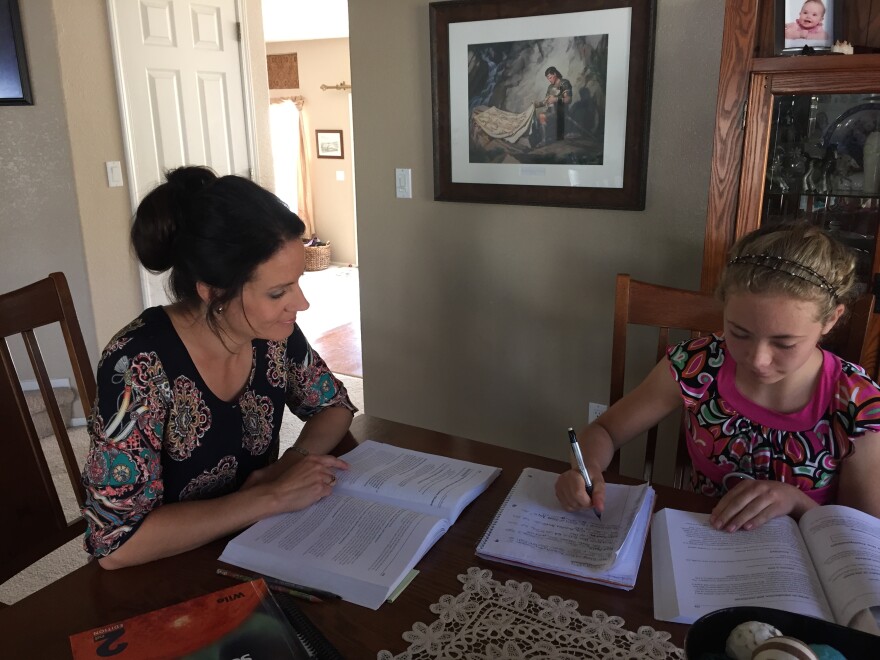Nevada lawmakers recently passed SB302, a landmark education bill. Today, as part of our series “Nevada’s Gamble on School Choice” Reno Public Radio’s Anh Gray explores the unforeseen consequences the new law could have on the state.
Eighth-grader Annika Dixon is playing Concerto in A Minor by Vivaldi. She typically starts her day practicing violin before sitting down at the family’s dining room table with her mother for a homeschool lesson. This morning, the subject is writing.
“After you write that narrative, the second step is you’re going to write a brief description of the poem structure,” Yvonne Dixon says.
Yvonne Dixon has four children and her three younger ones were just bussed off to their local public school. Annika is her oldest and has only been homeschooling for about a year.
“I don’t know at this point if I’ll be homeschooling the rest of my children,” Dixon says. “I think you have to look at each child individually and decide as a family which option is best for them.”
For Annika, homeschooling alleviates social pressures.
“And if I finish early,” Annika Dixon says, “I have extra time to do what I want during the day.”

Homeschooling is just one education option, along with charter schools, private schools, and distance learning. State Senator Scott Hammond authored SB 302—also known as the universal school choice bill. Last June, Nevada legislators passed the bill which subsidizes schooling alternatives for eligible students.
So far, Hammond says too much focus has been placed on students leaving public schools and taking state funding with them.
“It was never about just taking public money and transferring it to private schools,” Hammond says. “It was always about what’s the delivery of education and how it’s going to change in the future.”
Hammond says the goal is to spur even more innovation in education.
But, since the program is so new, it’s not possible to say how it’ll affect the state’s lagging education system. Russ Whitehurst is a researcher at the Brookings Institution. He studies school choice and says Nevada is now a trailblazer.
“This is a universal program, every family in the state who has a child who’s been attending public school is eligible to get this money, and that’s not the case anywhere else," Whitehurst says, “in that sense, that’s revolutionary.”
The law allows the state to deposit money in an education savings account—or ESA. The amount parents will receive is roughly $5,000 or 90% of the state’s spending per student. Families below federal poverty level and special needs students will receive 100% of the state’s funding.
But Whitehurst says there’s a problem with those amounts.
“It leaves the tuition payment for a private school out of reach for a low-income parent and that’s a bad thing if you’re interested in choice as a mechanism for equity,” Whitehurst says.
“This is going to be a huge failure for the students of Nevada,” Ruben Murillo says.
Ruben Murillo heads the Nevada State Education Association which represents about 28,000 education professionals. His agency opposed the bill citing a lack of equity and accountability.
Murillo expects the majority of ESA applicants will be suburban middle-class families. He’s also worried that the state doesn’t have a way to adequately measure student success, since participants can choose from several standardized tests.
“If parents can choose what test to take, how do we know if that test will give the result or give an accurate account of student’s capabilities or how much they learned,” Murillo says.
On top of that, there’s no minimum score tied to receiving the money. Even with that potential flaw in the program, Russ Whitehurst, the researcher we heard from earlier says school choice would at least shake up public education in Nevada.
“That disruption can lead to improvements,” Whitehurst says. “Imagine now that the public schools start losing a fair amount of students, they would think we’ve got to get better, we’ve got to compete and do some things differently.”
“I definitely think it could and will challenge the status quo. Whether or not it improves things, we’ll just have to wait and see,” Kim Metcalf says.
Kim Metcalf is the Dean of the College of Education at the University of Nevada, Las Vegas. Metcalf says there is no proven formula that guarantees academic success.
“If people knew with certainty how to effectively educate children in urban settings, they would do it,” Metcalf says. “It’s not that people know how and they refuse to do it.”
Metcalf describes implementing school choice as similar to a clinical drug trial—that it’s an experiment to collect evidence on what works and what doesn’t.

“The best we can do is to continue to try and improve what we’re doing,” Metcalf says, “and I think the danger is when we believe we have discovered an answer and hold so fast and uncritically to it that we fail to see where it may not be working.”
It will take some time to see if Nevada’s gamble on school choice pays off. But, waiting for a solution remains critical for the nearly half-a-million students enrolled in the state’s public school system.






